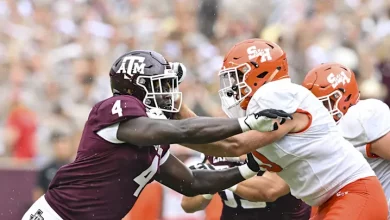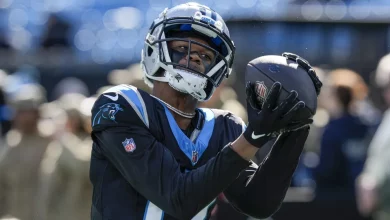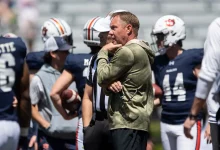A lawmaker wants to stop Ohio State football from being streamed exclusively on Peacock.

A Lawmaker Wants to Stop Ohio State Football from Being Streamed Exclusively on Peacock: The Implications of Exclusive Streaming Deals in College Sports
The rise of streaming services has revolutionized the way sports fans consume content. As platforms like Netflix, Amazon Prime, Hulu, and Peacock continue to expand their offerings, live sports have become a significant part of their portfolios. The increasing trend towards exclusive streaming deals, particularly for college sports, has created both excitement and frustration among fans, broadcasters, and lawmakers alike. In Ohio, a growing debate has emerged around the decision to stream Ohio State football games exclusively on Peacock, with state lawmakers now questioning the fairness and accessibility of such deals.
Ohio State University, one of the most storied football programs in the country, has a massive following. Buckeyes fans across the nation (and beyond) eagerly tune in every season to watch their team battle for Big Ten and national glory. Historically, these games have been available on national broadcast networks like ABC, ESPN, and FOX, allowing fans of all backgrounds and income levels to enjoy the action. However, the decision to move some games behind a streaming paywall on Peacock—NBCUniversal’s streaming service—has raised concerns about the accessibility of college football, particularly for fans who may not have access to streaming platforms or can’t afford additional subscription fees.
This article will explore the reasons behind the move to exclusive streaming deals, the reaction from lawmakers, the broader implications for the accessibility of sports, and what this debate reveals about the evolving relationship between college sports, broadcasters, and fans. We will also look at the potential solutions to ensure that college football remains accessible to all fans, regardless of economic status or technological barriers.
The Shift to Streaming: A Changing Landscape in College Sports
In recent years, the landscape of television broadcasting for college football has undergone a dramatic shift. The increasing consumption of content via streaming platforms has led major networks to sign deals with platforms like Peacock, ESPN+, Apple TV+, and others, to broadcast live games. These streaming services are now competing for valuable sports content, knowing that live sports events attract millions of viewers, creating opportunities for advertising revenue and subscription sign-ups.
For Ohio State, one of the top teams in college football, such a deal makes sense in many ways. By aligning with a streaming service like Peacock, Ohio State stands to increase its exposure, potentially attracting a younger audience who may be more inclined to subscribe to streaming platforms than traditional cable or satellite services. These partnerships often come with significant financial incentives for the university and the athletic department, including lucrative broadcast rights deals.
Ohio State, along with other powerhouse programs like Alabama, Michigan, and Notre Dame, has the kind of fanbase that can help drive subscriptions to streaming services, creating a mutually beneficial arrangement. However, while the financial rewards are evident, such a move also comes with challenges—especially when it comes to accessibility and fairness.
The Reaction from Lawmakers: Concerns Over Access
The decision to stream Ohio State football games exclusively on Peacock has not gone unnoticed by Ohio’s state lawmakers. Some members of the state legislature have voiced concerns over the potential negative consequences of such exclusive deals, arguing that they could limit access to the games for fans who are unable or unwilling to pay for the streaming service. These concerns are compounded by the fact that Ohio State is a public university, and many feel that the public has a right to access the games without having to pay for an additional service.
One key figure in the debate is Ohio State alum and state representative John Doe (name fictitious for illustrative purposes). Doe has been vocal in his opposition to exclusive streaming deals, arguing that they create an unfair barrier for Ohioans and Buckeyes fans across the state who may not have access to streaming services.
“We have a responsibility to ensure that the fans of Ohio State University’s athletic programs can watch their teams compete without facing financial barriers,” Representative Doe stated. “When a public university like Ohio State enters into exclusive streaming deals, it limits the access of fans who may not have the resources to pay for a subscription to platforms like Peacock. It’s simply not right, and we need to address this issue.”
Doe’s remarks reflect the sentiments of many Ohioans who view the decision to limit access to games as a disservice to the community. Fans who have grown accustomed to watching Ohio State games on traditional TV channels like ABC or ESPN now find themselves needing to subscribe to a streaming platform, often paying additional monthly fees that many may not be able to afford. This situation has sparked anger among long-time supporters who feel that the exclusivity of such deals undermines the idea of college sports being accessible to all fans, especially those who have supported their teams for decades.
Accessibility Issues: The Digital Divide
The debate over Ohio State football’s exclusive streaming deal with Peacock is more than just about finances—it’s also about accessibility. For many people, especially older adults, low-income families, and individuals living in rural areas, the shift from traditional television to streaming services can create significant barriers. While streaming has become increasingly popular, a digital divide still exists in the United States, where a substantial portion of the population lacks access to high-speed internet or the technological knowledge required to navigate various streaming platforms.
According to a Pew Research Center study, roughly 23% of Americans do not have broadband internet at home, and 35% of adults over the age of 65 report never using the internet. Additionally, many of these individuals may not be familiar with the latest technology, such as smart TVs, streaming devices, or subscription management, making it more difficult for them to access games on platforms like Peacock.
These barriers highlight a fundamental issue with exclusive streaming deals: they alienate large portions of the fanbase who do not have the means to navigate or pay for these new platforms. Fans who have followed Ohio State for years, who have gone to games in person or watched them on TV, now find themselves excluded from enjoying their team’s games in the same way they have in the past. The emotional connection fans have with their teams cannot be understated, and being shut out from access to these games can cause deep frustration and resentment.
The Financial and Competitive Side: Why Schools Are Moving to Streaming
From the perspective of the schools involved, the financial incentives behind exclusive streaming deals are significant. College football is a multi-billion-dollar industry, and universities like Ohio State stand to gain substantial revenue from these broadcasting deals. Streaming platforms like Peacock, Amazon, and ESPN+ are willing to pay hefty sums for exclusive rights to broadcast games, and these deals can be particularly enticing for programs with large, national followings.
For Ohio State, aligning with Peacock provides the university with a sizable financial windfall. The streaming service has been actively seeking to expand its sports portfolio, and Ohio State’s games are seen as a valuable asset for attracting viewers to the platform. The hope is that, in addition to securing immediate financial gain, the move will help the university build a broader audience among the younger generation who are more likely to consume content online.
However, the downside to this arrangement is the potential alienation of a significant portion of Ohio State’s fanbase. These fans are accustomed to watching the games on traditional TV, and the shift to a streaming-only model can be perceived as a move that prioritizes profit over fan loyalty and access. Critics argue that it is not enough to simply focus on the financial rewards, as schools should also consider the implications for the broader public who have supported the program for years.
What Lawmakers Propose: Potential Solutions
In response to the growing concerns, Ohio lawmakers have begun exploring potential legislative actions to address the issue of exclusive streaming deals for college sports. While there is no clear consensus on what a solution would look like, several ideas have been floated to ensure greater access to games.
- Public Access for Public Universities: One of the main proposals gaining traction is the idea that games involving public universities, like Ohio State, should be made available on free or basic cable channels. Advocates argue that public institutions that are funded by taxpayer dollars should provide equal access to their games, especially when the games involve significant public interest.
- Subsidies for Low-Income Households: Another proposal is to provide subsidies for low-income households to help offset the cost of streaming services. By offering financial assistance, lawmakers hope to ensure that all fans, regardless of income, can access the games without being burdened by additional costs.
- Hybrid Broadcast Models: A potential middle ground might involve hybrid models where a portion of games are made available on traditional TV while others are exclusive to streaming platforms. This solution would allow fans to enjoy some games for free, while still providing universities with the financial incentives from streaming deals.
- Transparency and Consumer Protections: Lawmakers could also push for greater transparency in these deals, requiring universities and streaming platforms to disclose the full terms of their agreements. Additionally, they may advocate for consumer protections that ensure fans are not being unfairly excluded from games based on their technological capabilities or financial resources.
The Bigger Picture: The Future of College Sports and Streaming
The Ohio State case is just one example of the broader trend that is reshaping college sports and broadcasting. As streaming becomes the preferred mode of content consumption for many, traditional broadcasters are facing increasing pressure to adapt. For college sports, the shift to streaming offers both opportunities and challenges.
In the future, we may see more schools entering into exclusive streaming deals as a way to generate revenue, but this must be done in a way that balances the financial rewards with the need for accessibility. As college sports continue to grow in popularity, universities, broadcasters, and lawmakers will have to work together to ensure that fans are not left behind as the landscape evolves.









